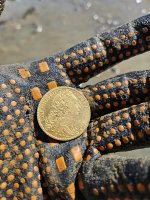uniface
Silver Member
1. Prismatic. As the name suggests, cross-section is triangular; two flat sides meeting in a central ridge running the length of it.

This one, considerably retouched along its edges and one end modified, was found in Coffee Slough, Alabama -- probably a stone's throw from Dust Cave (famous archaeological dig you can probably pull free info up on from the internet if Late Paleo on in Alabama is of interest) -- and is river stained Dover chert. I got it from Jerry Sherman, who got it from Jerry Dickey who, unfortunately, doesn't seem to have recorded the finder's name (unless he found it himself ?).
The Dust Cave site report notes that no blades were found at the deepest levels, but that they had been found, like this one, in the vicinity.
If of interest, the peachstate arch. society has a nice page on these Dalton era tools.
https://peachstatearchaeologicalsociety.org/index.php/17-flaked-stone-tools/178-dalton-scraper
The other common blade type is trapezoidal -- having three top facets:

This one (also river stained), of black Buffalo River/Dover chert, was found in Tennessee by Lashanne Johnson. It was homesick, so it went off to live with TennMountains for ten years or so. But he got tired of it & kicked it back to me. Many thanks again, Richard. I got to missing it after a while.
It's seen some hard use, but is intact. And is a good example of Doc G's observation that while Aurignacian blades had been made for use as tool stock (European paleolithic), Clovis (and Cumberland) blades were, primarily, used as-is.
The little nicks along the arises (ridges where flake scars meet) indicate that it was carried in a bag for some distance with others, knocking and grinding against them.

This one, considerably retouched along its edges and one end modified, was found in Coffee Slough, Alabama -- probably a stone's throw from Dust Cave (famous archaeological dig you can probably pull free info up on from the internet if Late Paleo on in Alabama is of interest) -- and is river stained Dover chert. I got it from Jerry Sherman, who got it from Jerry Dickey who, unfortunately, doesn't seem to have recorded the finder's name (unless he found it himself ?).
The Dust Cave site report notes that no blades were found at the deepest levels, but that they had been found, like this one, in the vicinity.
If of interest, the peachstate arch. society has a nice page on these Dalton era tools.
https://peachstatearchaeologicalsociety.org/index.php/17-flaked-stone-tools/178-dalton-scraper
The other common blade type is trapezoidal -- having three top facets:

This one (also river stained), of black Buffalo River/Dover chert, was found in Tennessee by Lashanne Johnson. It was homesick, so it went off to live with TennMountains for ten years or so. But he got tired of it & kicked it back to me. Many thanks again, Richard. I got to missing it after a while.
It's seen some hard use, but is intact. And is a good example of Doc G's observation that while Aurignacian blades had been made for use as tool stock (European paleolithic), Clovis (and Cumberland) blades were, primarily, used as-is.
The little nicks along the arises (ridges where flake scars meet) indicate that it was carried in a bag for some distance with others, knocking and grinding against them.
Last edited:
Upvote
0

